Every hobbyist loves finding unique, colorful, and interesting fish to add to their display tanks. But if you have your eye on one of these seven aggressive saltwater fish, you may be asking for problems. They’re beautiful to look at and add quirks to any aquarium, but they also have MEAN STREAKS that go straight to the bone. If you’re not prepared to handle their aggression, you could find yourself managing fishy hostage situations.
Table of Contents: Aggressive Saltwater Fish
What makes these aggressive saltwater fish such handfuls? And what prompts ANY fish to turn to the dark side? You can follow the links below to find out. Or, if you’re curious about what makes certain fish more of a challenge to manage than others, you can read through the entire article. The choice is yours.
- Types of Aggression in Saltwater Fish
- 7 Aggressive Saltwater Fish
- Managing Aggressive Saltwater Fish
- For More Information
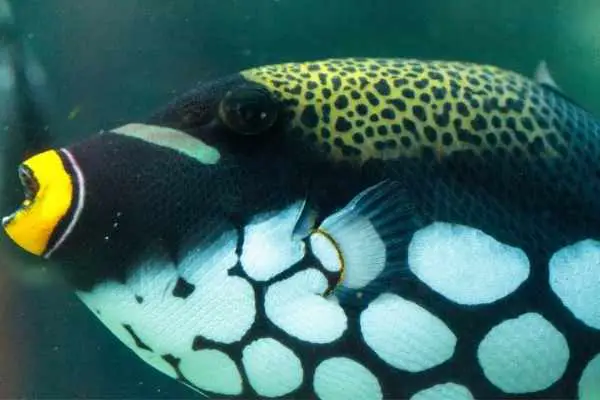
Types of Aggression in Saltwater Fish
Aggression among saltwater fish comes down to some pretty key factors, most of which you can probably guess at. You can see a predator/prey relationship, where one fish treats another animal as food. Then you have territorial species. Once they set up a patrol over an area, they don’t want any other fish or invertebrates to violate the perimeter. This could be due to the resources (i.e., food) in the territory, or it may be because of what’s found inside the boundaries. And, finally, you can have aggressive saltwater fish that grow defensive during the spawning season.
If you’re SUPER lucky, you may encounter a species that combines all of these into one handy package. (For the record, you’re probably better off housing them on their lonesome)
Predator/Prey Relationships
Predator/prey “aggression” happens when a fish decides to eat another inhabitant because it looks tasty. This comes in at the bottom of the aggressive saltwater fish “mean list,” mostly because it’s natural. Carnivores and omnivores eat meat. If you’re not aware of the preferred diet of your fish species, you may translate a “snack attack” as aggression. In reality, though, you supplied the meal. Thorough research into your fish can help prevent accidental losses.
Territorial Aggression
Territorial aggression shows up when a fish decides another fish (or, in some cases, ANY LIVING CREATURE) crossed the imaginary line onto their “property.” The ocean’s a rough and tumble place, with limited access to nutrients, mates, and even hiding places. By establishing a patroled territory, fish carve out what belongs to them. And aggressive saltwater fish, in particular, put their fins down on sharing.
However, behavioral fish studies demonstrate that aggressive fish in established territories will defend the territory from outside fish. But if you reverse the order of placement (placing the aggressive fish into the tank LAST), the aggression isn’t as significant.
Food Aggression
If your fish need to compete over access to food, you can find yourself coping with food aggression. While it isn’t a hard and fast rule, aggressive saltwater fish tend to come in on the large side of the scale. This not only means they need more nutrients and calories to supply their bodies, but they also have the weight to throw around and muscle the other tank residents out of the way. A hungry bully WILL shove smaller fish out of the way for that last morsel of algae. (What? You thought aggressive saltwater fish were only meat-eaters?)
Obviously, checking that you’re keeping the food supplies adequate can calm down the feeding frenzy. But you may also need to consider whether you have TOO MANY specialized diets in the house. Multiple grazers or copepod feeders will decimate the ready supply in an average tank. And that means you’ll end up with a hangry fish on your hands.
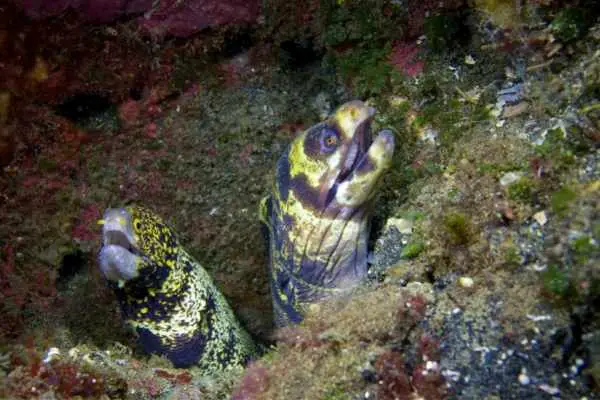
Mating Aggression
Some fish spawn without a second thought. The parents release their gametes and go on their way. But others form pairs or harems, performing displays to attract their desired mate. This can lead to aggression and even battles between males until the female makes her choice. And the problems don’t necessarily stop there.
Some aggressive saltwater fish guard their developing offspring. If any fish swim too close to the eggs, the parents will drive the invaders off. You’ll also find species that continue their parental care toward their fry. And if you don’t take steps to provide “privacy” for the new family, the tank mates may get attacked – simply for being in the neighborhood.
7 Aggressive Saltwater Fish
Now that you have an idea of the kinds of aggression you can expect to see let’s dive into a list of some of the biggest offenders. This list of seven aggressive saltwater fish should ring alarm bells when you spot them in the fish store. Sure, they’re gorgeous and unique. But you’ll want to use caution when adding them to your tank. Or – better yet – think about avoiding them altogether. (At least, hold off until you feel up to the challenge of managing them and their mean streaks)
Clown Triggerfish
No one can deny the clown triggerfish (Balistoides conspicillum) looks fantastic. They also have big personalities to match their common name. And when you spot them as juveniles in a fish store? You might find yourself lured in by their shy demeanor, hiding out within live rock. (Triggerfish use their dorsal fin to “lock” themselves in place inside caves at night)
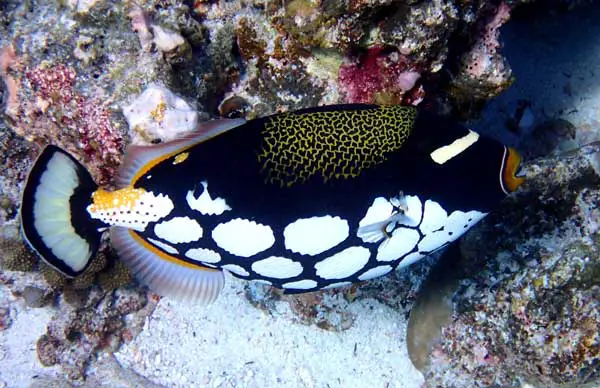
The problem comes as these fish grow larger and get older. That’s when they start to show their true colors – in more ways than one. They lose that initial fear and start to take on ANY fish that breaches the perimeter of their territory. Meanwhile, they like to “rearrange the furniture,” knocking over corals and the same live rock structures they used to hide out in.
You’ll also find yourself battling to keep them from snacking on your tank crustaceans. Nothing’s off-limits when it comes to their diet, and they don’t particularly care how much you spent on your cleaner shrimp.
If you happen to throw caution to the wind and bring home a mated pair, you then have the joys of dealing with nest-guarding behavior. The males hunker down over the nests and chase off any potential threats to the developing eggs.
Taken together? Yeah, that makes the clown triggerfish easily one of the worst aggressive saltwater fish for someone to deal with. (Cute but psycho)
Hawkfish
Sometimes you need to balance the pros and cons of aggressive saltwater fish. For instance, when you consider one of the hawkfish (Cirrihitidae). Hawkfish perch on corals or rock to survey their territory for food. And when they spot something delicious? They “swoop” down to snatch it up. (That’s where the common name “hawkfish” comes from) All of the fish in the family lack a swim bladder, making this the most effective method of hunting. (Not to mention it’s super cool to watch!)

As you might guess, though, they’re carnivores. And the teeth in their sharp little “beaks” are designed for breaking into the hard shells of their favorite invertebrates. This means your prize crustaceans (once again) can find themselves on the menu. But hawkfish don’t stop there. While they don’t grow as large as the clown triggerfish, they’re not above hunting anything smaller. This can include blennies or gobies – fish that like to hang out on the bottom of the tank. If a little fish shows up “anywhere the light touches,” it’s free game.
Hawkfish don’t even get along well with one another – unless you provide them with TONS of room. That’s how territorial they are. They set up harems in the wild, but they also cover dramatic ranges. A home aquarium? It’s not the same. And these unique little hunters? They’re aggressive!
Three Striped Damselfish
When you’re first setting up your saltwater aquarium, you might hear someone suggest a three striped damselfish (Dascyllus aruanus). People used to recommend popping one or two of these cute (inexpensive) fish into tanks to cycle them. Damselfish, in general, ARE hardy enough to withstand the shifting nitrogen levels, but you’re going to end up stuck with them for the long haul. Because once they find all of the crevices in the live rock? You’re not going to get the fish OUT of the tank ever again. And that’s a problem because they have a wicked Napoleon Complex.
Three striped damselfish (incidentally, there is a four stripe out there, which has an additional black band on the tail) definitely belong on the list of aggressive saltwater fish. As soon as they hit the tank, they set up a territory. And NO ONE’S safe if they violate the boundary. Little fish become snacks or harassed. Big fish? They get nipped and chased out! (No sense of self-preservation here)
If you bring in a pair? They’ll build a nest the male will guard. That means the aggression quotient goes UP. (And, really, do you want MORE of this aggressive saltwater fish swimming around in the tank?)
You already know they’re hardy, too. They can withstand conditions that’ll kill most other fish species. And removing the fish usually requires dismantling the entire tank. So think VERY carefully before you decide to add one.
Purple Tang
The surgeonfish, or tangs, possess “scalpels” on their tail that they wield menacingly to defend themselves. (It’s why they’re called “surgeonfish”) Any time you decide to add a tang to your display tank, you must remain aware of the scalpel to protect yourself and the fish. But this quirk of anatomy isn’t the only thing setting the purple tang (Zebrasoma xanthurum) apart as an aggressive saltwater fish. (Mostly because EVERY tang comes equipped with one)
Purple tangs do two things throughout the day: swim and graze. If you don’t provide them with enough room to remain active, you’ll end up with the famous tang aggression spiking even higher. This goes double if you decide to spring for a wild-caught fish over one raised in captivity. Downgrading from the ocean to an aquarium? They’re not fans. And aquarists often struggle to provide enough fin room to keep their tang from harassing everyone else in the tank.
But that room serves another crucial aspect: grazing space. Purple tangs feed on macroalgae CONSTANTLY. That’s how they have enough energy to remain active. Without enough food provided – and you’ll know because you’ll have a “plump” fish – you get a hangry fish. (No one wants that) This means you’re better off keeping the purple tang as your ONLY grazer. Otherwise, they’ll fight with the other fish for the available food.
And as if that weren’t enough? This aggressive saltwater fish can turn grumpy before bed! As it cruises around looking for a spot to sleep, aquarists note it chasing other fish out of the way.
Maroon Clownfish
When you hear “clownfish,” you probably think of Marlin and Nemo. So why is there a clownfish on the list of aggressive saltwater fish? Because the maroon clownfish (Amphiprion biaculeatus) isn’t your “fishy friend.” These massive members of the family consistently rank in the top 20 of popular species to keep in saltwater aquariums, but they’re also known to bite hands!
Maroon clownfish have spines within their cheeks (they’re also known as spinecheeks). Those spines allow them to go after other fish that infringe on their territory. And that territory? It’s the entire tank. Once they enter a space, they claim everything as THEIRS. They’ll harass any fish that come near them. That includes one another! Female maroon clownfish grow significantly larger than males. When a female in a mated pair decides to have a bad day, she can chase her partner EVERYWHERE until he finds a hiding spot!
As you might expect, these clownfish continue the tradition of guarding their eggs. Both parents take turns (though the male does most of the work). And they’ll defend the nest from anyone that comes near (including you). Their reputation as one of the most aggressive saltwater fish out there remains firm. You might want to skip them – or at least go with ONE instead of a pair.
Snowflake Eel
When you spot a snowflake eel (Echidna nebulosa) as a juvenile in a store, you may find yourself charmed by the small, thin, beautifully marked. But don’t be fooled. This is another aggressive saltwater fish that shows its true colors as it ages.
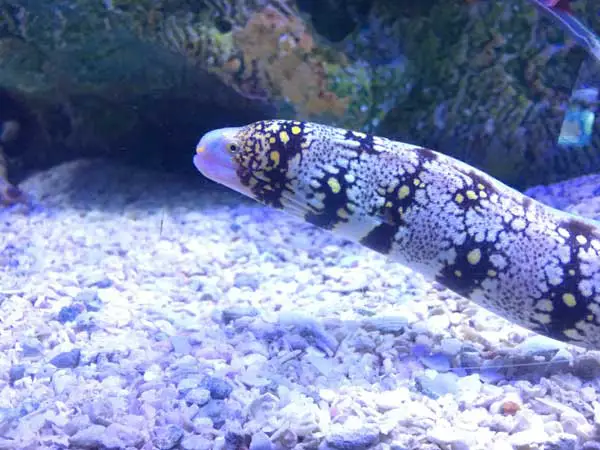
Snowflake eels are members of the moray eel family. And while they’re not as aggressive as their moray cousins, you still need to keep that predatory nature in mind. They will eat any fish they can catch and fit into their mouths. And that can make feeding time a challenge. They smell fantastic, but sight? It’s not so great in those tiny eyes. So as soon as dinner hits the tank, the snowflake eel will come out and start searching for anything that MIGHT work. That means crustaceans and small fish.
Being an eel, it also does an excellent job at getting into and out of tight crevices. They might topple rockwork in their haste to chase down a meal. This means there’s nowhere for your fish to hide – and EVERYWHERE for your eel to sneak into. Or OUT of. Snowflake eels are notorious escape artists. While that particular habit doesn’t affect their placement on the list of aggressive saltwater fish, it’s something you need to keep in mind.
Lionfish
Finally, you can’t discuss aggressive saltwater fish without paying tribute to the King of the Saltwater Aquarium. Lionfish (Scorpaenidae) attract any hobbyist looking for unique features – or that allure of danger. After all, you need to remain aware of those venomous spines along the dorsal fins at all times. (While they may feel similar to bee stings to most people, you CAN have an allergic reaction)
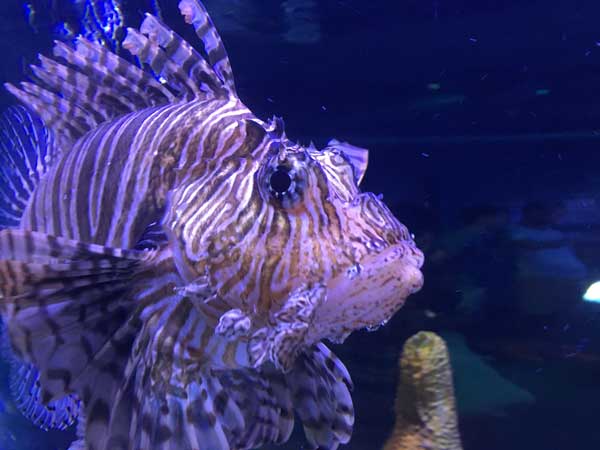
When it comes to aggression, though, even the smallest lionfish pack a mean streak. They’re carnivores that lie in wait to ambush their prey. And they’re not particular about WHAT that prey might be. Lionfish happily snatch up crustaceans and fish – so long as it fits in their mouth. This is one of the reasons they’re so effective as invasive species throughout the Caribbean and Gulf of Mexico. (Also, they’re incredibly hardy and adaptable)
If you don’t want to battle this aggressive saltwater fish, avoid mixing it with ANYTHING small enough to fit in its mouth. They can’t control their eating reflex. Most aquarists prefer to make this a single-species display – just to stay on the safe side.
Managing Aggressive Saltwater Fish
Now, these aggressive saltwater fish are too gorgeous, unique, and amazing to pass up forever. And they’re only the tip of the iceberg. You’ll encounter PLENTY of species out there with their individual mean streaks. That means understanding what to do.
You already know the driving factors behind most aggression. So you know the best ways to handle things:
- Research the diets of your fish ahead of time. Then you won’t accidentally pair predator and prey.
- Always introduce territorial fish into an aquarium LAST. This way, they won’t claim the entire tank as their property.
- Provide proper food amounts. If you don’t have enough algae? Don’t try to cram more than one aggressive saltwater fish that likes to graze into your tank.
- Have a separate breeding tank prepared for nesters. Then your community tank won’t need to cope with parental aggression.
For More Information
Still want to find out the best ways to deal with aggressive saltwater fish? This YouTube video will provide some additional helpful tips and tricks:
You can also read up on how to handle your aggressive saltwater fish in more detail: Dealing with Aggression Between Fish.
Conclusion
Aggressive behavior happens; there’s nothing you can do about that. But it’s important to plan how to respond to that aggression. Decide on the order for the fish in your tanks and make sure you’re keeping compatible species. If you know you’re keeping fish KNOWN for their aggressiveness, use caution. You can’t coax natural tendencies out of fish. However, you CAN work within those tendencies and keep your tank a healthy environment – for everyone. (Yup, even the bullies)

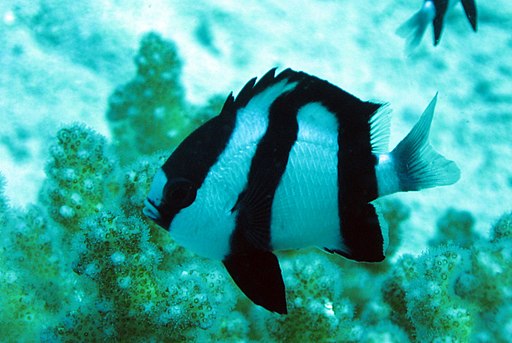

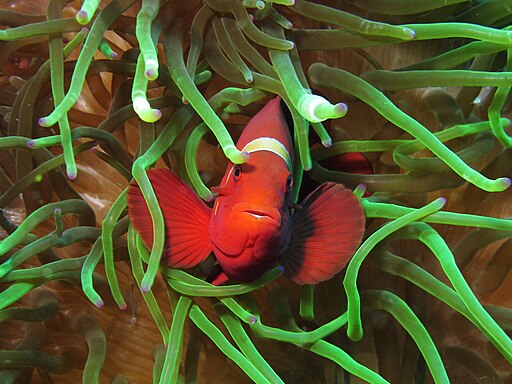
Leave a Reply